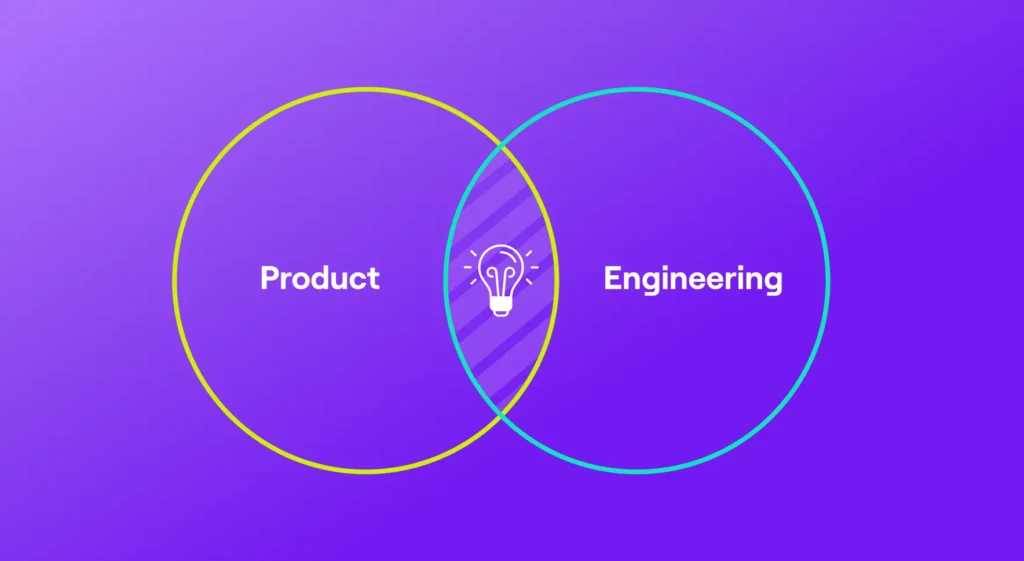There’s a dynamic that goes on at companies that no one really talks about. Specifically, there are two very different “subcultures” that exist, and they have a huge impact on engineering leaders. There’s an “engineering culture” and a “business culture,” and – lucky for you! 😉 – your role as an engineering leader sticks you squarely in the middle of the two when they inevitably find themselves at odds with one another. It’s the engineering leaders who have to constantly try to play to both sides. Because you have to navigate this dynamic, I’d like to discuss what these potentially conflicting cultures are, and how we might be able to navigate this whole messy situation.
Comparing the business and engineering cultures
Let’s start by thinking about a few words you’d use to describe most engineering cultures. I’ll throw out a few: open [as in open-source, wikis etc], team-oriented, agile (of course!). We LOVE our teams for these things, and we should! Our teams often think before they say or act, and they don’t make promises until they’re certain they can deliver. I’m generalizing but you’ll see where I’m going with this.
Let’s do the same exercise…but with sales. I’ll throw out a few words so you don’t have to ;). Results-oriented, hierarchical, and definitely performance-based. The relationship between an individual sales rep and the business is as follows: if you produce X results, you get Y, and it impacts the company bottom line by Z. It’s all documented and transparent, but in a different kind of way.
What’s the Challenge?
I’m not saying one culture is better than the other; each culture is a byproduct of the core role they play in the company. But I bring this up because about 99.999% of the time, the “business culture” (exemplified by sales) IS the default culture at the exec/leadership level. And if it’s the default culture, that means we have a responsibility to figure out how to engage engineering culture within it.
In a world where sales culture is the default, part of our role is to bridge, connect, and highlight what is great about engineering while also ensuring your team is not cut off at the knees because it operates differently. The challenge is giving the business what it needs, while also allowing the amazing culture that you’ve built to thrive.
Here are a few thoughts on how you can do both.
Inside Voice, Outside Voice
The needs of Engineering and Sales are often completely opposing. Engineering’s core function is to figure out how best to build the next feature. Engineering teams often operate in prioritized lists, estimate work in story points, and want a process that allows discovery, sprint planning, ideation.
Sales and marketing teams are selling new products, upsells, creating sales plans, and launching campaigns. Their core function is to increase revenue through selling products, and they need to know what new things are coming and when. Sales cultures are transactional and outcome-focused because that’s what they need to get their job done.
So in a cross-functional meeting, your head of sales will inevitably ask you, “When’s that feature going to ship?” They’re not doing this to be in your biz but instead because they need to know this to effectively perform their function. And in their view, the best answer is clear and concise: “It will be ready on X date.” From an engineering culture perspective, often an ideal answer is more nuanced. For example, maybe we have 16 stories left in the epic, and the burndown says that it could be done by the end of the Sprint 12, but I really can’t say because there’s some architecture that isn’t done yet and Jocelyn hasn’t started coding it yet. This, of course, contrived answer shares the full sausage making and ambiguity that is the engineering process. It’s honest, transparent, and explains why you’re not able to commit to a hard date. But to a sales leader, they a) still don’t have what they need, and b) they’ll be left wondering some version of, “Why can’t they just provide me with a date?”
My best advice in these situations is to use your “inside voice” with one group – one that’s measured and precise, and your “outside voice”, one that’s open, loud, without abandon with another. With engineering, take a thorough approach and use your “outside voice.” With your engineering team, talk about all the nuances and risks of delivery. To your leadership peers, use your “inside voice”- one that shows precision, clarity and answers their questions. Provide clear and concise answers to their questions so that they can effectively plan.
It can be hard to boil down the complexity and variance of engineering to hard specific dates, but it doesn’t mean we shouldn’t try. From the earlier example, while you probably can’t pin it to a specific date, you can pin it to a range, which will incrementally help sales plan. For example, is this feature going to ship by next year? “Of course, duh”. Is it highly likely in the next 3-6 months? Then say that. It’s not the exact date they were looking for, but it will incrementally help them plan, giving them what they need, avoiding over-commitment, and acknowledging the nuance and variability that is engineering.
They never tell you these things
Candidly, we’re put in an impossible position. They never tell you when you take the job about these types of nuanced needs. Frankly, most CEOs don’t even know that their engineering leaders are required to do these types of things. But that’s why great engineering leaders are not just great former engineers; they’re also great leaders both within and outside their orgs. If you’re doing your job well, your exec peers might never know that you have an “inside voice” or an “outside voice.”






